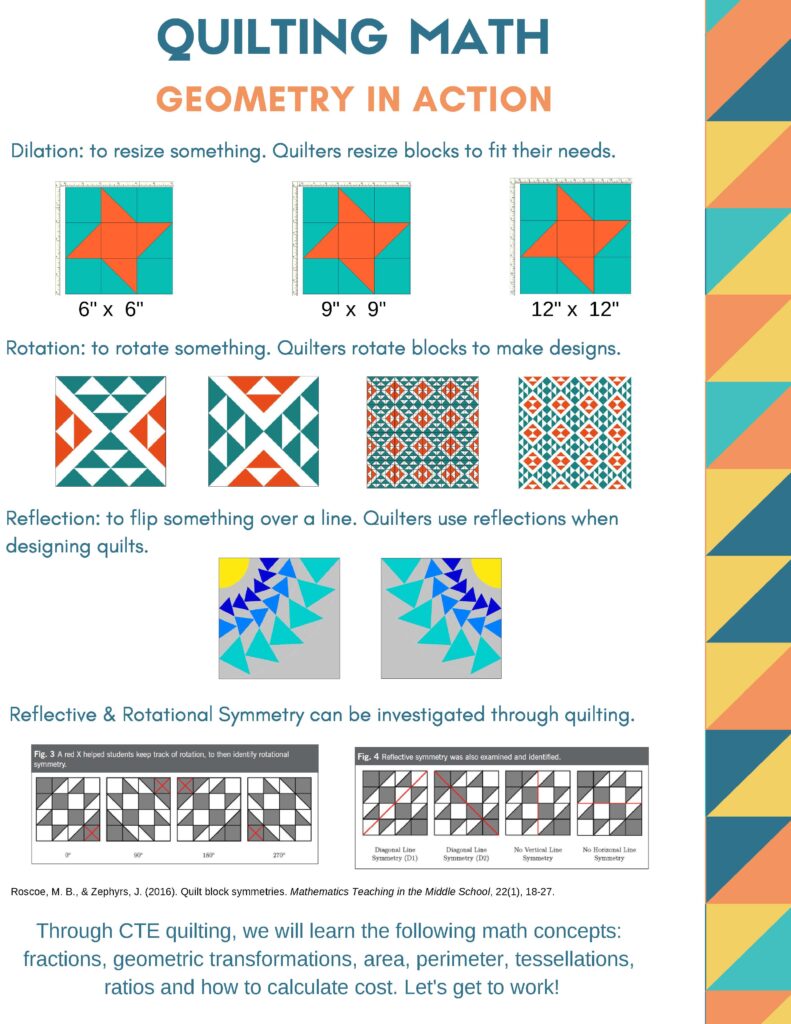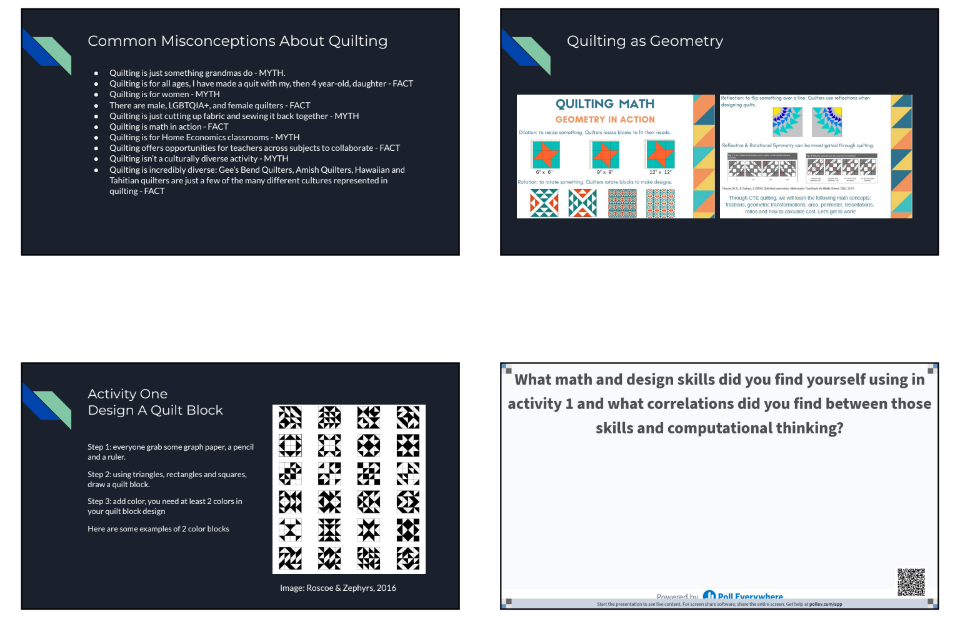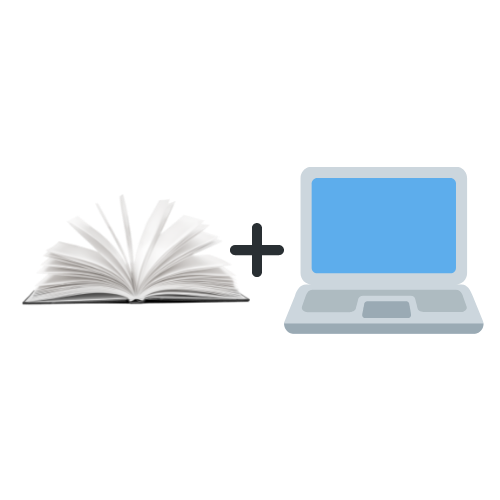The community engagement project for EDTC 6104 – Digital Learning Environments – centers around developing a conference proposal.
I contemplated several possible topics for my presentation and settled on one that I believe is relatively unique. My proposed topic is: Computational Thinking in Action – Quilt Math. I have written about quilting and technology multiple times during my DEL program courses. Quilting is an important part of who I am, not only on a personal level, but on a professional level as well. I run a unique program at the middle school level and I firmly believe that there are many cross-curricular applications for quilting.
I decided that a 2-hour workshop at NCCE would be the most appropriate venue for my presentation. There are several reasons for this, but one of the most important is that it is local to me, which would make attending it very economical.
Target Audience
My target audience is STEM/STEAM teachers – specifically teachers of math, computer science, CTE textile arts, home economics, and art teachers. These educators are already practicing in the STEM/STEAM field and will likely be interested in cross-disciplinary collaboration and/or learning a different approach to computational thinking instruction.
Here is a brief synopsis of my workshop proposal:
Computational thinking is an important life skill, not only for the Computer Sciences, but for everyday problem solving. This session will cover the following topics:
- Definition of computational thinking and the skills involved.
- The everyday applications of math & computational thinking.
- Why and how quilting can be used to teach computational thinking.
- Break down the computational thinking steps in relation to quilt design.
- Ending with a group activity where we will make a “quilt” utilizing our computational thinking skills.
Additionally, you will learn how math/computer science and CTE/Art/Family can collaborate to build an engaging and creative program designed to not only teach math, but teaching the life skill of quilt making.
Reflection
The process of developing a conference proposal was very labor intensive, but it is a process that I can now apply to all aspects of professional conference planning. The skills I learned will work for any type of conference that I would like to apply to present at. As an educator, I am used to standing up in front of people and presenting information. However, my typical audience is 11-14 year-olds. Presenting to adults is an intimidating prospect for me. I know that this skill is one that I need to practice in order to develop and as I desire to be an instructional coach in the future, it is a skill that I need to master. Planning for and presenting at a conference has and will provide me with invaluable experience.
My presentation is designed to address the following ISTE Coaching Standards:
- ISTE Coaching Standard 4.3 Collaborator (ISTE, n.d.):
- 4.3a: Establish trusting and respectful coaching relationships that encourage educators to explore new instructional strategies (ISTE, n.d.)
- 4.3b: Partner with educators to identify digital learning content that is culturally relevant, developmentally appropriate and aligned to content standards.
- 4.3c: Partner with educators to evaluate the efficacy of digital learning content and tools to inform procurement decisions and adoption.
- 4.3d: Personal support for educators by planning and modeling the effective use of technology to improve student learning (ISTE, n.d.).
The presentation will also explain to teachers how they can address the ISTE student standards as well as WA state computer science standards:
- ISTE Standards for Students: (ISTE) standard 1.5 – Computational Thinker.
- 1.5c – “Students break problems into component parts, extract key information, and develop descriptive models to understand complex systems or facilitate problem solving” (ISTE, n.d.).
- 1.5d – “students understand how automation works and use algorithmic thinking to develop a sequence of steps to create and test automated solutions” (ISTE, n.d.).
- WA computer science standards (Thissen, 2018):
- 2-DA-08: Collect data using computational tools and transform the data to make it more useful and reliable.
- 2-DA-09: Refine computational models based on the data they have generated.
- 3A-AP-13: Create prototypes that use algorithms to solve computational problems by leveraging prior student knowledge and personal interests.
In addition to developing the workshop slideshow, I will also be using 2 handouts that I created. The first one was created 5 years ago for my thesis and the second was created specifically for computational thinking.


I have included flipped learning, blended learning and resilient pedagogy. For the flipped learning, I will be asking that those taking the course pre-watch 2 videos on the definition of a quilt. What are quilts? by the International Quilt Museum, and The History of Quilting in Four Minutes by the National Wool Museum of Australia. For my blended learning I am having students participate in not only hands-on activities, but also interactive polls. See the screenshots below.


Finally, I have created a video that is meant to be viewed after completing the workshop. As the workshop focuses on making “quilt blocks” with paper, the video demonstrates how to make a quilt block using fabric. I demonstrate the computational thinking process, start-to-finish, in the video.
This presentation, combined with the pre- and post- learning activities is an example of a powerful professional development course for teachers to take. I am both excited and nervous about the prospect of presenting this workshop. Having quilting recognized as a legitimate way to teach core subject skills has been a passion of mine since I became a teacher. This workshop will hopefully give me an opportunity to do just that. With the advice of Dr. Wicks, I also decided to approach, Cheryl Steighner, to be a co-presenter. She was one of my professors for Teaching, Learning, and Assessment II in the Spring. I am excited to say that Cheryl said yes, and I submitted the proposal to NCCE on August 21, 2022. I hope to hear back sometime in October regarding whether or not it has been accepted.
References
Asli, A., & Zsoldos-Marchis, I. (2021). Teaching applications of mathematics in other disciplines: Teachers’ opinion and practice. Acta Didactica Napocensia, 14(1), 142-150. https://files.eric.ed.gov/fulltext/EJ1308677.pdf]
Costa, E, Campos, L., & Dario Serey Guerrero, D. (2017). Computational thinking in mathematics education: A joint approach to encourage problem-solving ability. IEEE Frontiers in Education Conference (FIE), 2017, 1-8. https://ieeexplore.ieee.org/abstract/document/8190655
Haser, Ç., Doğan, O.,& Erhan, G. (2022). Tracing students’ mathematics learning loss during school closures in teachers’ self-reported practices. International Journal of Educational Development, 88. https://doi.org/10.1016/j.ijedudev.2021.102536
International Society for Technology in Education. (n.d.). ISTE computational thinking competencies. ISTE. https://www.iste.org/standards/iste-standards-for-computational-thinking
International Society for Technology in Education. (n.d.). ISTE standards: Coaches. ISTE. https://www.iste.org/standards/iste-standards-for-coaches
International Society for Technology in Education. (n.d.). ISTE standards: Students. ISTE. https://www.iste.org/standards/iste-standards-for-students
McCoy, L., & Shaw, J. (2003). Patchwork quilts: Connections with geometry, technology, and culture. Reston, 9(1) 46-50.
National Council of Teachers of Mathematics. (n.d.) Process. National Council of Teachers of Mathematics. Retrieved August 2, 2022, https://www.nctm.org/Standards-and-Positions/Principles-and-Standards/Process/
Paznokas, L. (2003). Teaching mathematics through cultural quilting. Teaching Children Mathematics, 9(5) 250-256. https://doi.org/10.5951/TCM.9.5.0250
Strecker, K. (2021, October 5). Cross-curricular instruction. Curriculum Leadership Institute. https://cliweb.org/cross-curricular-instruction/
Rozogonjuk, D., Kraav, T, Mikkor, K., Orav-Puurand, K., & Täht. (2020). Mathematics anxiety among STEM and social science students: The roles of mathematics self-efficacy, and deep and surface approach to learning. International Journal of STEM Education, 7 (46). https://doi.org/10.1186/s40594-020-00246-z
Thissen, S. (2018). Computer Science. https://www.k12.wa.us/sites/default/files/public/computerscience/pubdocs/cs-standards.pdf
